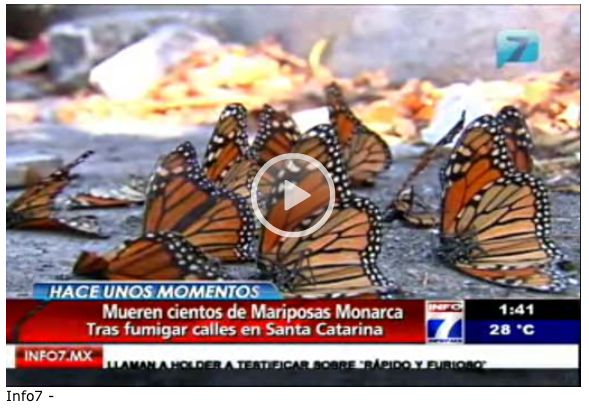A deadly blast of Dengue fever insecticide sprayed on trees just outside Monterrey this week cut the migration short for several hundred Monarch butterflies. The unfortunate massacre illustrates the challenges of balancing reasonable insect control and management with conservation efforts.
The report below by Gerardo Boruga of Info7, a news service of Azteca Noreste, shows hundreds of Monarch butterflies writhing in the street after a fumigation truck passed through the Santa Catarina neighborhood of Monterrey in Nuevo Leon province and sprayed their roost in an effort to control the spread of the sometimes fatal Dengue virus.
Dengue fever, caused by a virus carried by mosquitoes, continues creeping north from tropical climes to U.S. cities. “The global resurgence of Dengue virus is a real issue,” Dr. Marty Cetron, director of the Center for Disease Control’s division of global migration and quarantine, told a Boston news service this week.
No cure for Dengue fever exists, but scientists continue work on a vaccine.

Hundreds of Monarch butterflies were killed in Santa Catarina, Mexico, about 500 miles from their ancestral roosts in Angangueo, Michoacan
The primary management tools for controlling the spread of Dengue fever–insecticide use and habitat removal–also threaten the health of the Monarch butterfly migration. Gardeners know this quandary well. Indiscriminate spraying of insecticides kills desirables as well as pests.
The Santa Catarina Monarch massacre serves as a sobering reminder of the complex aspects of conserving our beloved Monarch butterfly migration. As we butterfly fans detail daily sightings of late season stragglers throughout the eastern United States on Facebook and on the D-PLEX*, let’s not forget the conservation challenge at hand.
Fumigation programs combat dangerous diseases, but the fallout can be a pile of dead butterflies. Illegal logging at the Monarch roosts in Michoacan results largely from a lack of economic opportunity; people must feed their familes and heat their homes in those remote Mexican mountains. Some (not me) might cast the development of herbicide tolerant crops, a practice that has decimated native milkweed (the Monarch butterfly host plant) in our heartlands, as another economic development issue.
Education and coordination can make a big difference. As reporter Boruga says in his report, the episode could have been avoided with a simple change in the fumigation schedule. “They’re only here for a night or two,” Boruga points out, suggesting a day or two delay in fumigating could have allowed the Monarchs to make it to Michoacan.


The are essentially two types of logging at the overwintering site in Michoacan, “illegal” and “legal.”
Illegal logging is cartel controlled and is clandestinely done in the Protected Zone. Large areas on mountain tops have been logged. Some areas have been discovered only by satellite images.
Legal logging is done in the Buffer Zone by certain Ejidos that own the land. A certain amount of wood is needed for heating and cooking. Some areas are cleared for crops.
Presence of the Mexican Army has cut down on illegal logging.
Monarch ecotourism is being promoted with financial assistance going to the Ejidos and there are re-forestation efforts underway to replant the oxymal fir forest.
Horrible — have you heard any public comments from those who ordered the fumigation? I hope increased media on incident will push those responsible to do some sort of mitigation such as create a special area in Santa Catarina dedicated to the monarch migration. This could be a new public park highlighting education on the migration and providing plentiful nectar sources for the butterflies….
Dengue Fever in Mexico??!! I missed that. What a tragedy that this wasn’t coordinated with whatever Mexican agency handles natural resources and wildlife management. Sort of makes you wonder whether local residents were informed beforehand.
Ken